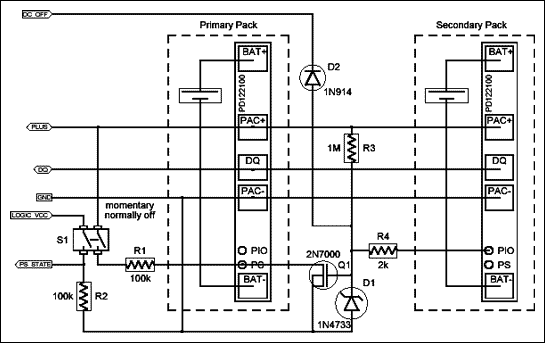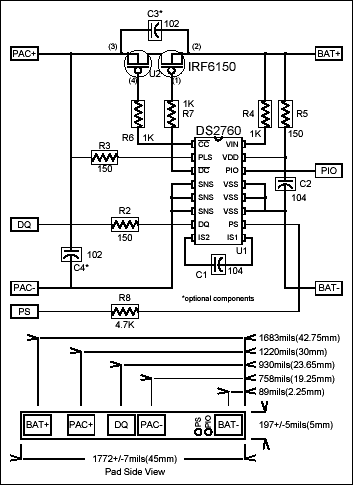
IntroductionOne of the advantages of the DS27xx series of integrated Li-Ion protection products, and in particular the DS2760, is the capability to monitor and control battery power delivery within multi-battery systems. This application note will demonstrate an implementation of a circuit that supports the switching of multiple battery sources without power loss contention. It is recommended that the reader become familiar with the DS2760 datasheet, particularly the SWAP, PMOD, PS, and PIO functions, before reading this document.

Multi-Pack Configuration
General System DescriptionIt is assumed that the end equipment may be supplied power from a primary pack, a secondary pack, or a DC source. The power switch function of the primary pack is the locus of all used initiated power activity. In the case of a battery powered environment, the momentary closure of S1, the power switch, will wake the primary pack, supplying power to an initially powered-down system. If the system is presently powered, the depression of the power switch has no consequence and is simply reported to the system as an asynchronous user event. In an active system, battery power is switched via issuance of a 1-Wire interface sequence (set DE = 0). Finally, the hot extraction of the active power source, other than the primary pack, will force the primary pack onto the power bus in a manner similar to that of a power switch closure.
Detailed DescriptionThe circuit above utilizes the PD122100 demo board as the basis of a standard implementation of a battery management circuit. The PD122100 schematic is provided for reference on the last page of this document. This product provides power control of the individual batteries as well as features outside the scope of this applications note (see DS2760 High Precision Li-Ion Battery Monitor data sheet). The DS2760s in both the primary and secondary packs are programmed to enable the SWAP command (STATUS:SWEN = 1) and SLEEP MODE (STATUS:PMOD = 1). The SWAP command, issued through the common 1-Wire data interface DQ, is the primary means of switching battery power under host control. The DC source gaining control of the common switched power bus, PLUS, is conditional on the power state of the equipment. If the system is off (PLUS low) and DC is applied, PLUS will be driven by DC. In the case where the system is battery powered and DC is applied, the system will grant DC control of power by the issuance of a SWAP command to a non-existent device, disengaging all packs, followed immediately by the gating of DC onto PLUS. Though the details are system-dependent, the DC source control circuit must power the equipment if PLUS was low prior to the DC insertion. Further DC must be controlled by a switch to avoid contention when PLUS is battery powered. The signal DC_OFF is provided to avoid a PLUS contention caused by a power switch (S1) request and facilitates uninteruptable power if DC is removed during system operation. In this implementation, DC_OFF will be driven to GND on DC present and high-Z in DC's absence. The pack labeled primary is designated to be operable in the case of a hot extraction of either the DC source or the secondary battery. In the case when a battery only system is powered off, the primary battery will initiate power through the detection of a closure on switch S1. Prior to SWAPing from the primary to secondary pack, the system will set the PIO bit in the DS2760of the secondary battery. This has the same effect for the secondary pack as DC_OFF low did for DC in that both the S1 induced power contention and the maintenance of un-interruptible power issues are addressed.
SummaryBy the judicious use of the SWAP, PMOD, PS, and PIO functions of the DS2760, the complexities of multi-pack power switching systems are simply addressed. Hot extraction recovery, problematic in any system, is addressed by the channeling of the appropriate removal detection signals into the power switch control input (PS pin) of a predestinated battery pack.

PD122100 CSP Demo Board
欢迎分享,转载请注明来源:内存溢出

 微信扫一扫
微信扫一扫
 支付宝扫一扫
支付宝扫一扫
评论列表(0条)